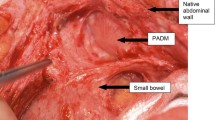Abstract
The purpose of this study is to compare primary repair procedure with those that use bio-concordant materials in the treatment of urethrocutaneous fistula. Twenty-five New Zealand rabbits were randomly placed into five groups (primary repair, free graft, allograft fascia lata, alloderm and bovine pericardium repair groups). A single dose of 20 mg/kg of ceftriaxon was applied intramuscularly as a prophylactic dose. Urethrocutaneous fistula was formed on midpenile level. Later, while primary repair was applied in one group, repair with free grafts and with other bio-concordant materials were performed in other groups. Urinary diversion was not used in any of the rabbits. The macroscopic observation was evaluated with urethrography obtained 21 days after the operation and then the rabbits were sacrificed. A total point was obtained by awarding a point to each good parameter in the histopathological evaluation and all the groups were compared. The urethrographic findings and macroscopic examinations were normal in all groups. In histopathological examinations, ranging from the best to worst results, bovine pericardium group (8 points) had a better total score than primary repair group (7 points), allograft fascia lata group (7 points) and alloderm group (7 points). The free graft group had the worst total point (6 points). Bio-concordant materials can be used in urethrocutaneous fistula repair as an alternative to primary repair or to the grafts obtained from body tissues.




Similar content being viewed by others
References
Latifoglu O, Yavuzer R, Unal S, Cavusoglu T, Atabay K (2000) Surgical treatment of urethral fistulas following hypospadias repair. Ann Plast Surg 44:381–386
Elbakry A (2001) Management of urethrocutaneous fistula after hypospadias repair: 10 years’ experience. BJU Int 88:590–595
Kilic A, Emsen M, Ozdengil E (2000) Urethral fistula as the cause of circumcision phobia. Ann Plast Surg 45(2):214
Grandhi TM, Shelley O, Ray AK, McGregor JR (2004) Dorsal urethral fistula: case report and review of literature. Urology 63(1):175–176
Fenner DE (2000) New surgical mesh. Clin Obstet Gynecol 43(3):650–658
Edney MT, Lopes JF, Schned A, Ellsworth PI, Cendron M (2004) Time course and histology of urethrocutaneous fistula formation in a porcine model of urethral healing. Eur Urol 45:806–810
Canning DA (2003) Management of recurrent urethral fistulas after hypospadias repair. J Urol 170(1):327–328
Kargi E, Yesilli C, Akduman B, Babuccu O, Hosnuter M, Mungan A (2003) Fascia lata grafts for closure of secondary urethral fistulas. Urology 62(5):928–931
Chtourou M, Attyaoui F, Ben Younes A, Rekik H, Horchani A (2000) Repair of urethrocutaneous fistula with double skin flap. Report of 32 cases. Prog Urol 10(2):261–264
Devine CJ Jr, Horton CE (1961) A one stage hypospadias repair. J Urol 85:166–172
Zhang R, Cheng K, Wang S (2000) Urethra fistula repair without using a urethral stent. Zhonghua Zheng Xing Wai Ke Za Zhi 16(5):281–283
Hafez AT, Herz D, Bagli D, Smith CR, McLorie G, Khoury AE (2003) Healing of unstented tubularized incised plate urethroplasty: an experimental study in a rabbit model. BJU Int 91(1):84–88
Campodonico F, Michelazzi A, Ognio E, Favre A, Carmignani G (2003) Patch urethroplasty using a fascia lata autograft in male rabbits. Urol Int 71(3):242–245
Nanni L, Vallasciani S, Fadda G, Perrelli L (2001) Free peritoneal grafts for patch urethroplasty in male rabbits. J Urol 165(2):578–580
Richter F, Pinto PA, Stock JA, Hanna MK (2003) Management of recurrent urethral fistulas after hypospadias repair. Urology 61(2):448–451
Yang S-X, Yao Y, Hu Y-F, Song C, Wang L-L, Jin H-M (2004) Reconstruction of rabbit urethra using urethral extracellular matrix. Chin Med J 117(12):1786–1790
Lara RC, Lucon AM, Arap S (2004) Urethroplasty using a bovine pericardium graft: an experimental study using normal urethras from dogs. Braz J Med Biol Res 37(3):327–331
Author information
Authors and Affiliations
Corresponding author
Rights and permissions
About this article
Cite this article
Ayyildiz, A., Çelebi, B., Akgül, K.T. et al. A comparison of free skin graft, fascia lata, alloderm, bovine pericardium and primary repair in urethrocutaneous fistulas without diversion: an experimental study. Pediatr Surg Int 22, 809–814 (2006). https://doi.org/10.1007/s00383-006-1769-6
Accepted:
Published:
Issue Date:
DOI: https://doi.org/10.1007/s00383-006-1769-6




